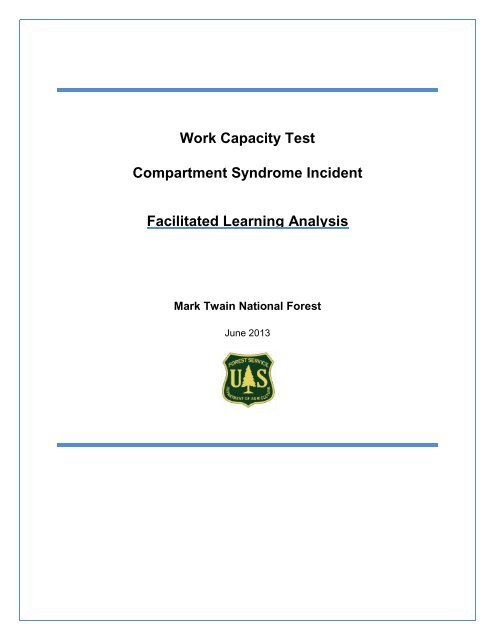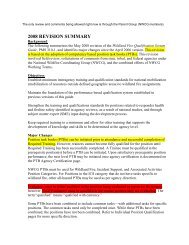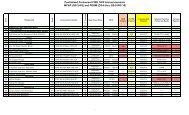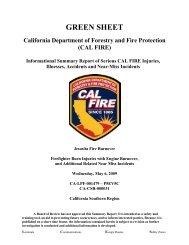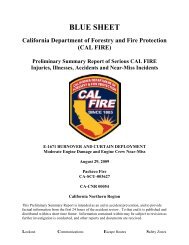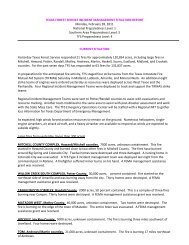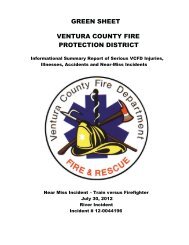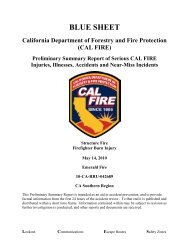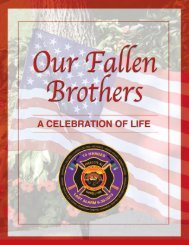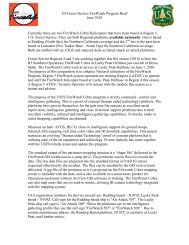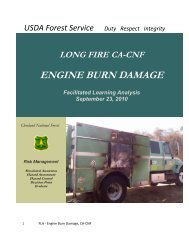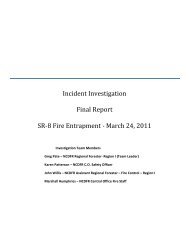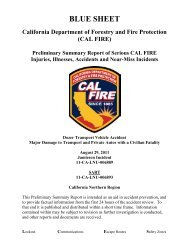Pack Test Compartment Syndrome FLA - Wildland Fire Lessons ...
Pack Test Compartment Syndrome FLA - Wildland Fire Lessons ...
Pack Test Compartment Syndrome FLA - Wildland Fire Lessons ...
You also want an ePaper? Increase the reach of your titles
YUMPU automatically turns print PDFs into web optimized ePapers that Google loves.
Work Capacity <strong>Test</strong><br />
<strong>Compartment</strong> <strong>Syndrome</strong> Incident<br />
Facilitated Learning Analysis<br />
Mark Twain National Forest<br />
June 2013<br />
Work Capacity <strong>Test</strong> • <strong>Compartment</strong> <strong>Syndrome</strong> Incident • Facilitated Learning Analysis<br />
1
“The Facilitated Learning Analysis process helps us to<br />
maximize learning opportunities presented by unintended<br />
outcomes or near miss events. The intent is to improve<br />
performance by generating individual, unit, and<br />
organizational learning that capitalizes on shared<br />
experience—blaming is replaced by learning.”<br />
Facilitated Learning Analysis<br />
Implementation Guide<br />
Work Capacity <strong>Test</strong> • <strong>Compartment</strong> <strong>Syndrome</strong> Incident • Facilitated Learning Analysis<br />
2
Contents<br />
I. Leader’s Intent…..………………………………………………….……….… 4<br />
2. Sequence of Events………………………………….………….……..……. 5<br />
3. <strong>Lessons</strong> Learned from Participants…………………...……..…………..… 10<br />
4. Recommendations……………………………………………………………. 11<br />
5. Commendations…………………………………..……………..….……..…. 11<br />
6. Facilitated Learning Analysis Team……………………….……………..… 12<br />
Work Capacity <strong>Test</strong> • <strong>Compartment</strong> <strong>Syndrome</strong> Incident • Facilitated Learning Analysis<br />
3
I. Leader’s Intent<br />
This Work Capacity <strong>Test</strong> “<strong>Compartment</strong> <strong>Syndrome</strong>” Incident occurred on February 6, 2013 on<br />
the Mark Twain National Forest. [See “<strong>Compartment</strong> <strong>Syndrome</strong>” definition on page 8.]<br />
On February 11, 2013, Forest Supervisor William B. Nightingale elected to conduct a Facilitated<br />
Learning Analysis (<strong>FLA</strong>) of the incident, the employee’s treatment, and outcomes.<br />
The Forest Supervisor’s Delegation of Authority directed the <strong>FLA</strong> Team to produce a report that:<br />
Conveys key aspects of the incident, lessons learned, and recommendations for others<br />
to consider in administering the Work Capacity <strong>Test</strong>—or when faced with a potential<br />
<strong>Compartment</strong> <strong>Syndrome</strong> event.<br />
In the spirit of a learning culture, builds upon the learning associated with a similar<br />
incident that occurred on the Chequamegon-Nicolet National Forest on September 9,<br />
2011 [http://wildfirelessons.net/documents/<strong>Compartment</strong>_<strong>Syndrome</strong>_Rhabdo_<strong>FLA</strong>.pdf].<br />
Validates the facts and medical outcome of the incident.<br />
Explores the use of virtual meetings and Video Teleconferencing Equipment (VTC)<br />
where appropriate.<br />
Work Capacity <strong>Test</strong> • <strong>Compartment</strong> <strong>Syndrome</strong> Incident • Facilitated Learning Analysis<br />
4
2. Sequence of Events<br />
On February 12, 2013, two <strong>FLA</strong> Team members interviewed—by telephone—the employee<br />
who was injured during the Work Capacity <strong>Test</strong>. The <strong>FLA</strong> Team also spoke with the<br />
employee’s fiancé.<br />
On February 27, 2013, three <strong>FLA</strong> Team members met with the Work Capacity <strong>Test</strong><br />
administrators and personnel from the Mark Twain National Forest fire management staff to<br />
discuss the events surrounding the February 6, 2013 Work Capacity <strong>Test</strong>.<br />
Wednesday, Feb. 6 – <strong>Pack</strong> <strong>Test</strong><br />
The Work Capacity <strong>Test</strong> site was a local school’s ¼ mile track. The administrator and<br />
administrator trainee arrived at approximately 9:30 a.m. Some Work Capacity <strong>Test</strong> (commonly<br />
known as the “<strong>Pack</strong> <strong>Test</strong>”) participants were already stretching and warming up.<br />
The day was sunny, approximately 45 degrees, with a slight breeze. The heat stress factor was<br />
deemed to be low during this period.<br />
A total of 17 people were signed-up to take the test, two at the “moderate” level, and the<br />
remaining 15 people at the “arduous” level.<br />
The participants were briefed. The Job Hazard Analysis (JHA) was reviewed and signed by all<br />
participants. No concerns were mentioned.<br />
A local ambulance was used to provide emergency medical support during the <strong>Pack</strong> <strong>Test</strong>. Once<br />
the ambulance arrived on scene, the administrator started the test. (The ambulance was there<br />
for assistance but was not dedicated to the test. If it was dispatched to another call, the <strong>Pack</strong><br />
<strong>Test</strong> would have to be suspended.)<br />
A fire manager who had transferred from another<br />
region commented on the professional manner in which<br />
the test was set-up and conducted.<br />
Employee’s Apparent Fitness Level<br />
Edward [not the employee’s actual name], a collateral<br />
duty firefighter, was at the site in time to stretch.<br />
Several employees noticed that he was in good<br />
physical condition—with a “heavy build—body builder<br />
type.” These employees say he “looked ready to take<br />
the test.” (Edward had taken the <strong>Pack</strong> <strong>Test</strong> every year<br />
since 2002. He had always passed. He remembers<br />
having some pain in his legs after some of these <strong>Pack</strong><br />
<strong>Test</strong>s—never during.)<br />
In their initial interview with Edward, the <strong>FLA</strong> Team<br />
learned that—prior to this <strong>Pack</strong> <strong>Test</strong>—he was running<br />
four to five miles every other day and does resistance<br />
training (push-ups, squats, and sit-ups) on his nonrunning<br />
days.<br />
Work Capacity <strong>Test</strong> Definition<br />
“Work Capacity <strong>Test</strong>s (WCT) are used to ensure that<br />
persons assigned to fire activities are physically capable<br />
of performing the duties of wildland firefighting and to<br />
meet National Wildfire Coordinating Group (NWCG)<br />
standards for wildland firefighters (<strong>Wildland</strong> <strong>Fire</strong><br />
Qualification Subsystem Guide 310-1, NWCG, 1993).”<br />
“<strong>Pack</strong> <strong>Test</strong>: The <strong>Pack</strong> <strong>Test</strong> is a job-related test of the<br />
capacity for arduous work. It consists of a 3-mile hike<br />
with a 45-pound pack over level terrain. A time of 45<br />
minutes, the passing score for the test, approximates an<br />
aerobic fitness score of 45, the established standard for<br />
wildland firefighters.”<br />
“Arduous: Duties involve field work requiring physical<br />
performance calling for above-average endurance and<br />
superior conditioning. These duties may include an<br />
occasional demand for extraordinarily strenuous<br />
activities in emergencies under adverse environmental<br />
conditions and over extended periods. Requirements<br />
include running, walking, climbing, jumping, twisting,<br />
bending, and lifting more than 50 pounds; the pace of<br />
work typically is set by the emergency condition.”<br />
National Wildfire Coordinating Group’s<br />
Glossary of <strong>Wildland</strong> <strong>Fire</strong> Terminology<br />
Work Capacity <strong>Test</strong> • <strong>Compartment</strong> <strong>Syndrome</strong> Incident • Facilitated Learning Analysis<br />
5
Edward said that the night before the <strong>Pack</strong> <strong>Test</strong> he<br />
had a light meal of broccoli, cheese, and rice. He<br />
takes no vitamins or supplements and does not<br />
regularly consume energy drinks.<br />
On his way to the <strong>Pack</strong> <strong>Test</strong>, Edward stopped at a<br />
store for water and a candy bar.<br />
<strong>Pack</strong> <strong>Test</strong> Culture Discussion<br />
The physical requirement for <strong>Wildland</strong> firefighters<br />
demands a high level of fitness. The Work<br />
Capacity <strong>Test</strong>s (WCT) separates firefighters from<br />
other employees based on the WCT as a condition<br />
of hire. Some individuals believe this division has<br />
helped to establish a culture of accepting pain that<br />
is potentially produced by the <strong>Pack</strong> test.<br />
This common acceptance of pain as being part of<br />
the <strong>Pack</strong> <strong>Test</strong> perhaps leads participants to believe<br />
that any post-<strong>Pack</strong> <strong>Test</strong> pain or discomfort must<br />
simply be “normal” muscle pain.<br />
<strong>Pack</strong> <strong>Test</strong> Performance<br />
Prior to taking the “arduous” <strong>Pack</strong> <strong>Test</strong>, Edward told<br />
one of the lap counters that he knew how fast he<br />
needed to go to pass. He said that he planned to not strain, just keep a steady pace.<br />
As the <strong>Pack</strong> <strong>Test</strong> started, Edward’s earphones were tangled in his vest. He stopped to untangle<br />
his earphones. It took approximately one minute to fix the earphones and readjust his vest.<br />
Because he had lost a bit of time, the administrator asked Edward if he wanted to wait and start<br />
separately. Edward declined; he wanted to continue.<br />
Without straining, he was able to catch the rest of the group before the end of the first lap. He<br />
set a constant pace and did not seem to be under any significant stress.<br />
Prior to the <strong>Pack</strong> <strong>Test</strong>, Edward had wrapped his lower right leg with ice. Due to knee surgery on<br />
his left leg in 1985, he has a very particular gait to his walk. During the <strong>Pack</strong> <strong>Test</strong>, this gait<br />
became noticeable to others. Edward stated that this gait does not affect his physical abilities.<br />
As Edward performed the <strong>Pack</strong> <strong>Test</strong>, he chatted with other participants and acknowledged the<br />
lap counters as he circled the track. He said he never felt any stiffness or pain during the test.<br />
The Mark Twain National Forest (MTNF) advises employees to bring their own water to the<br />
<strong>Pack</strong> <strong>Test</strong> as it is not provided at the test site. Edward was new to this Forest. Previously, he<br />
had taken the <strong>Pack</strong> <strong>Test</strong> in another Region, where he was used to water being supplied at the<br />
track.<br />
Post <strong>Pack</strong> <strong>Test</strong><br />
After the <strong>Pack</strong> <strong>Test</strong>, Edward took off his weight vest and ran one more lap and then stretched<br />
for approximately 15 minutes. It was during this stretching that Edward began to feel pain in his<br />
right leg’s calf area. As Edward walked back to the government vehicle, his legs were getting<br />
stiffer. Because his leg was causing him pain, when Edward and his fellow employee left the<br />
<strong>Pack</strong> <strong>Test</strong> site, Edward asked the other employee to drive.<br />
They arrived back at the their Ranger District at approximately 12:30—almost two hours after<br />
the <strong>Pack</strong> <strong>Test</strong> had been completed. Upon their arrival, Edward told the other employee that he<br />
couldn’t put any pressure on his right leg. “When I got to the District,” Edward recalls, “I couldn’t<br />
get out of the truck. Finally, using my left leg to get out, I lay down on the ground and stretched<br />
for approximately 30 minutes.”<br />
Next, when he tried to walk to the District office building, he made it as far as the outside office<br />
door—where the pain in his leg forced him to sit for approximately ten more minutes. When he<br />
got up and entered the building, he only made it as far as the conference room, where the pain<br />
and inability to walk forced him to collapse onto the floor. Edward said a coworker brought him<br />
Gatorade and two Tylenols. He said he lay there for approximately 35 minutes. He said that the<br />
Tylenol did not alleviate his pain.<br />
Work Capacity <strong>Test</strong> • <strong>Compartment</strong> <strong>Syndrome</strong> Incident • Facilitated Learning Analysis<br />
6
Edward said he was finally able to make it to his desk—where he alternated doing his work and<br />
getting up and walking around. Another employee told Edward that—based on how he was<br />
feeling—he should go to the hospital.<br />
Goes Home Early—Then to Hospital<br />
Due to the continuing and escalating pain in his leg, Edward decided to go home early that day.<br />
Because to try to bend his right leg caused him so much pain, he had to use his left leg—<br />
operating three pedals—to drive his standard transmission vehicle home.<br />
After Edward returned home—around 2:30 p.m.—he continued to be in pain. He took a “long,<br />
hot” shower and put his leg on ice. “But it didn’t help,” Edward says. He took two more Tylenol.<br />
At this point, he also noticed that his urine was very dark in color. He attributed this to being<br />
dehydrated.<br />
That night in bed, it was impossible to sleep. The slightest pressure on his right leg, even just<br />
the weight of his hand, was extremely painful. Due to the severity of the pain associated with<br />
this condition, it was difficult for Edward to walk. He says he could only “crawl around on the<br />
floor.” He called his fiancé (who lives in another state). After consulting with his fiancé, Edward<br />
drove himself to the hospital—once again using solely his left leg to negotiate the vehicle’s<br />
pedals. (He drove an “automatic” transmission vehicle this time.)<br />
At approximately 9 p.m., Edward was admitted to the Emergency Department. At first, because<br />
they could find nothing wrong, they were about to release him. They then took a blood test<br />
which revealed that Edward’s Creatine kinase (CK) level was 19,000. Normal levels should be<br />
between 40 and 600. The CK level in blood tests is used as a marker of Rhabdomyolysis (see<br />
definition on next page).<br />
Edward was admitted to the hospital and put on an IV with saline solution. No pain medicine<br />
was administered.<br />
The Next Day, Thursday, Feb. 7 – At the Hospital<br />
The next morning, a District employee received an unclear text from Edward. After a delay, they<br />
were able to contact Edward to learn that he had been admitted to the hospital the night before.<br />
The employees immediately notified personnel at both the District and the Supervisor’s Office.<br />
At 2 p.m. that day, the Zone <strong>Fire</strong> Management Officer (FMO) and another employee went to the<br />
hospital to check on Edward. At that time, as far as anyone could tell, he was still just receiving<br />
saline solution by IV.<br />
Edward hadn’t eaten the hospital food. The employees, therefore, went to an Arby’s and<br />
brought him back a sandwich. They stayed at the hospital with Edward until 6 p.m.<br />
A “heads up” email from the FMO went out over the Region’s FMO mailing list. This message<br />
explained that an employee had been admitted to the hospital after the <strong>Pack</strong> <strong>Test</strong>. This<br />
information spurred a response from the Regional Fuels Specialist, wondering if “<strong>Compartment</strong><br />
<strong>Syndrome</strong>” had been considered as Edward’s ailment. The Region 9 Safety and Occupational<br />
Health Manager had also been notified. She cc’d an email to an employee in the Region who<br />
had suffered through <strong>Compartment</strong> <strong>Syndrome</strong> and Rhabdomyolysis in 2011. That employee<br />
wrote an email to the unit fire staff, explaining signs and symptoms and recommending getting a<br />
second opinion—and the need to do so quickly.<br />
Work Capacity <strong>Test</strong> • <strong>Compartment</strong> <strong>Syndrome</strong> Incident • Facilitated Learning Analysis<br />
7
What is ‘<strong>Compartment</strong> <strong>Syndrome</strong>’?<br />
“A condition that occurs when the amount of swelling and/or bleeding<br />
in a muscle compartment causes pressure that is greater than the<br />
capillary pressure and results in tissue ischemia (lack of oxygen) and<br />
potential tissue death.”<br />
From Athletic Training and Sports Medicine, 1999;<br />
Editor: Robert C. Schenck Jr., MD<br />
http://www.nwcg.gov/branches/pre/rmc/index.htm<br />
What is ‘Rhabdomyolysis’?<br />
“‘<strong>Compartment</strong> <strong>Syndrome</strong>’ can lead to ‘Rhabdomyolysis,’ the breakdown of<br />
muscle fibers resulting in the release of muscle contents (myoglobin) into<br />
the bloodstream. These releases can cause multiple symptoms and, if left<br />
undiagnosed, can lead to kidney and muscle damage, and in rare cases,<br />
results can be fatal.”<br />
May 12, 2011, Safety Alert on Rhabdomyolysis (“Rhabdo”) sent out by the NWCG’s<br />
Risk Management Committee: http://www.nwcg.gov/branches/pre/rmc/rhbdo_study.pdf<br />
District employees began researching “<strong>Compartment</strong> <strong>Syndrome</strong>” on the Internet. The Zone<br />
FMO talked with Edward and his fiancé (who had arrived from out of state). He suggested that<br />
Edward’s injuries could be related to <strong>Compartment</strong> <strong>Syndrome</strong>.<br />
The FMO arranged for Edward to speak on the phone with the Region 9 employee who had<br />
been diagnosed with <strong>Compartment</strong> <strong>Syndrome</strong> and Rhabdomyolysis after also completing the<br />
<strong>Pack</strong> <strong>Test</strong>.<br />
Edward’s fiancé and the local employees were concerned about the level of care that Edward<br />
was receiving at this hospital. They feared that if he was suffering from <strong>Compartment</strong><br />
<strong>Syndrome</strong>—to prevent other serious health consequences—there was only a small window of<br />
time when the appropriate medical actions must be administered.<br />
Decision Made to Transfer to Another Hospital<br />
At approximately 7 p.m. that evening, Edward’s fiancé talked with the doctor. The decision was<br />
made to move Edward to another hospital. Edward wasn’t transported until approximately 10<br />
p.m. He arrived at the new hospital at 11:30 p.m.<br />
Within an hour of his admittance, Edward was positively diagnosed with <strong>Compartment</strong><br />
<strong>Syndrome</strong>. Surgery preparation began. Edward was under sedation by 2:30 a.m.<br />
Edward’s fiancé told the <strong>FLA</strong> Team that the doctor was “extremely concerned” about the<br />
extended time period from when Edward’s pain began on Wednesday to his arrival and<br />
<strong>Compartment</strong> <strong>Syndrome</strong> diagnosis early Saturday morning.<br />
The surgical procedure—at 2:30 a.m.—included making three approximate nine-inch incisions<br />
on Edward’s right leg—from his knee down to his ankle. After the surgery, the doctor told<br />
Edward’s fiancé that, initially—due to the extended period that this condition had remained<br />
untreated—he had been worried that Edward’s leg could require amputation. However, when he<br />
operated, there was no dead muscle discovered in the leg.<br />
Work Capacity <strong>Test</strong> • <strong>Compartment</strong> <strong>Syndrome</strong> Incident • Facilitated Learning Analysis<br />
8
Monday, Feb. 11<br />
By now, Edward’s CK level has dropped significantly. He is able to navigate on crutches. The<br />
doctors believe that Edward could be released from the hospital under the care of a doctor near<br />
his “care-giver” fiancé’s home. He will need to undergo physical therapy for eight weeks. At that<br />
time, a determination will be made on his availability to return to work.<br />
Tuesday, Feb. 12<br />
Four days after his surgery, Edward is released from the hospital to recover and rehabilitate<br />
under his fiancé’s care out of state.<br />
March<br />
By the end of March, Edward is still undergoing his eight-week physical therapy process and is<br />
“doing better.”<br />
May<br />
Edward’s doctor releases him to go back to work on May 7. At that time, he starts teleworking<br />
from out of state. His physical therapy was to wrap up the last week of May.<br />
June<br />
With his doctor’s permission, Edward was set to return back to work at his District office the first<br />
week in June. For three to six months, he will be on light duty. The doctor stated that—until<br />
further notice—Edward will be able to stand/walk for only one hour per day.<br />
Work Capacity <strong>Test</strong> • <strong>Compartment</strong> <strong>Syndrome</strong> Incident • Facilitated Learning Analysis<br />
9
3. <strong>Lessons</strong> Learned from Participants<br />
Increased <strong>Compartment</strong> <strong>Syndrome</strong> Awareness<br />
During the <strong>FLA</strong> process, several employees said that they wished they had realized<br />
much sooner that <strong>Compartment</strong> <strong>Syndrome</strong> could be a factor. We need to raise<br />
employee and supervisor awareness and also local health care workers’ awareness.<br />
[Note: Since this <strong>FLA</strong> was started, a physician info sheet on <strong>Compartment</strong> <strong>Syndrome</strong><br />
and Rhabdomyolysis has been developed and is posted on the F&AM WCT website:<br />
http://www.fs.fed.us/fire/safety/wct/<strong>Compartment</strong>_<strong>Syndrome</strong>_Rhadbo_Physician_Hando<br />
ut.pdf.]<br />
While Rhabdomyolysis (“Rhabdo”) was talked about in their fire refresher training, there<br />
is a need to modify the Work Capacity <strong>Test</strong>’s Job Hazard Analysis (JHA) to include<br />
<strong>Compartment</strong> <strong>Syndrome</strong> and Rhabdo. Also, consider the Work Capacity <strong>Test</strong> literature<br />
and administrator’s guide as another place to include educational information on the<br />
risks and symptoms of <strong>Compartment</strong> <strong>Syndrome</strong> and Rhabdo. [Note: Since this <strong>FLA</strong> was<br />
started, the Work Capacity <strong>Test</strong> specific JHA has been updated and is posted on the<br />
F&AM WCT website: http://www.fs.fed.us/fire/safety/wct/wct_index.html.]<br />
Consider having an After Action Review (AAR) to discuss how people feel after taking<br />
the <strong>Pack</strong> <strong>Test</strong>. In addition, consider keeping participants around longer to allow the test<br />
administrators to monitor them. One thought was to have the administrator check every<br />
participant prior to leaving the test area—and having other personnel check-up on the<br />
participants later in the day.<br />
Medical Facilities/ Workman’s Compensation/Advocacy<br />
Employees need a greater awareness of OWCP processes (i.e. Workers<br />
Compensation), the agency’s role and employee’s role, HIPAA 1 related issues, advocacy<br />
questions, and general contact issues between the Albuquerque Service Center (ASC)<br />
and the employee. [Note: Workers Compensation has written a document to better<br />
facilitate these processes: Facilitating Treatment of Traumatic Injuries.]<br />
Anecdotal Conversation between Participants – Questions to Ponder<br />
Are personnel actually preparing for the <strong>Pack</strong> <strong>Test</strong>—or just showing up and taking it? If<br />
one doesn’t train, is the physical impact and associated pain potentially worsened?<br />
Are people properly preparing by practicing with a weight vest and walking? Or, due to<br />
their normal exercise routine, are they assuming that they are already “in shape” for the<br />
<strong>Pack</strong> <strong>Test</strong>?<br />
Several concerns were voiced about the current <strong>Pack</strong> <strong>Test</strong> culture that makes it difficult<br />
for someone to admit that the <strong>Pack</strong> <strong>Test</strong> “beat them.” Succeeding in the <strong>Pack</strong> <strong>Test</strong> has<br />
become a matter of pride that makes it very difficult for someone to admit that they were<br />
“not tough enough to complete it.”<br />
1 The Health Insurance Portability and Accountability Act of 1996 (HIPAA) was enacted by the U.S. Congress to protect health<br />
insurance coverage for workers and their families. It requires the establishment of national standards for electronic health care<br />
transactions and national identifiers for providers, health insurance plans, and employers.<br />
Work Capacity <strong>Test</strong> • <strong>Compartment</strong> <strong>Syndrome</strong> Incident • Facilitated Learning Analysis<br />
10
4. Recommendations<br />
Modify the literature (brochure, administrator’s guide) to reflect the risk of <strong>Compartment</strong><br />
<strong>Syndrome</strong>.<br />
Administrators should monitor participants immediately following the <strong>Pack</strong> <strong>Test</strong>. At this<br />
time, discuss how employees are feeling, watch for signs of unusual or extreme “pains,”<br />
discuss symptoms that could cause medical issues, ensure participants will be around<br />
other people during the next few hours (whether employees or family). In addition,<br />
ensure that these people are aware of the steps to take if ill health symptoms begin to<br />
emerge in this person who has recently completed the <strong>Pack</strong> <strong>Test</strong>.<br />
5. Commendations<br />
The <strong>FLA</strong> Team would like to commend several of the Mark Twain National Forest employees for<br />
their quick-thinking actions and proactive decisions regarding their efforts to assist Edward.<br />
These individuals took the initiative to research <strong>Compartment</strong> <strong>Syndrome</strong> and relay significant<br />
information to Edward and his fiancé.<br />
The <strong>FLA</strong> Team is certain that if these employees had not done so, the outcome of this medical<br />
incident could have been much more severe.<br />
Work Capacity <strong>Test</strong> • <strong>Compartment</strong> <strong>Syndrome</strong> Incident • Facilitated Learning Analysis<br />
11
6. Facilitated Learning Analysis Team<br />
Hurston A. Nicholas, Team Leader<br />
Forest Supervisor, Shawnee National Forest<br />
Karen Vanzo, Facilitator<br />
Safety/Occupational Health Manager, Chequamegon-Nicolet National Forest<br />
Joe Domitrovich, Ph.D., Medical – Subject Matter Expert<br />
Project Leader, Missoula Technology and Development Center (MTDC)<br />
Monica Neal, Document Specialist<br />
Forest Supervisor’s Executive Assistant, Shawnee National Forest<br />
Tristian Fluharty, Region 9 <strong>Fire</strong> and Aviation Management – Subject Matter Expert<br />
<strong>Fire</strong> Operations, Regional Office, Region 9<br />
Jon Teutrine, Shawnee National Forest <strong>Fire</strong> and Aviation Management – Subject Matter Expert<br />
<strong>Fire</strong> Management Officer, Shawnee National Forest<br />
Work Capacity <strong>Test</strong> • <strong>Compartment</strong> <strong>Syndrome</strong> Incident • Facilitated Learning Analysis<br />
12


